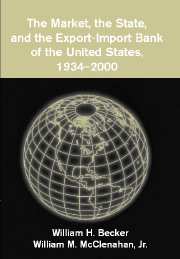Book contents
- Frontmatter
- Contents
- Preface and Acknowledgments
- Introduction
- 1 Setting a Flexible Course: The Export-Import Bank, 1934–1939
- 2 World War and Its Aftermath
- 3 Cold War and the Needs of a New Era, 1948–1961
- 4 Becoming “Two Institutions”
- 5 New Mandates and New Limits
- 6 Turmoil and Turning Points
- 7 A New Era and Its Challenges, the 1990s
- Epilogue
- Appendix A Board of Directors
- Appendix B Summary of Authorizations
- Appendix C Number of Authorizations
- Appendix D Charges Against Statutory Limitations on Total Activity
- Index
Introduction
Published online by Cambridge University Press: 13 July 2009
- Frontmatter
- Contents
- Preface and Acknowledgments
- Introduction
- 1 Setting a Flexible Course: The Export-Import Bank, 1934–1939
- 2 World War and Its Aftermath
- 3 Cold War and the Needs of a New Era, 1948–1961
- 4 Becoming “Two Institutions”
- 5 New Mandates and New Limits
- 6 Turmoil and Turning Points
- 7 A New Era and Its Challenges, the 1990s
- Epilogue
- Appendix A Board of Directors
- Appendix B Summary of Authorizations
- Appendix C Number of Authorizations
- Appendix D Charges Against Statutory Limitations on Total Activity
- Index
Summary
The Export-Import Bank of the United States is the government's official export credit agency (ECA). Throughout its history the Bank has promoted the financial needs of American exporters, but it has also served the goals of policy makers in the White House, as well as the Departments of the Treasury, State, and War (later Defense). In that sense, Ex-Im was not atypical when compared to the ECAs of other governments. What has been unusual in Ex-Im's history was the need to compete with foreign ECAs, which were the products of different political economies, serving governments that often had domestic and foreign agendas unlike those of the United States. Ex-Im has avoided competing with private sector institutions. That stricture, a part of its early congressional mandate, has shaped a government institution keenly attuned to the practices of financial market institutions. Additionally, the Bank focused on market principles because of the requirement that its lending be based on the assumption of a reasonable assurance of repayment.
Franklin D. Roosevelt created the Export-Import Bank in 1934 during the New Deal's earliest zeal for planning and building the power of the state. It now exists in an environment where leaders extol market solutions to economic growth and development in most places in the world. As this transformation suggests, Ex-Im has long conducted its business in an ever-changing realm defined by the shifting demands of both the state and the market.
- Type
- Chapter
- Information
- Publisher: Cambridge University PressPrint publication year: 2003

